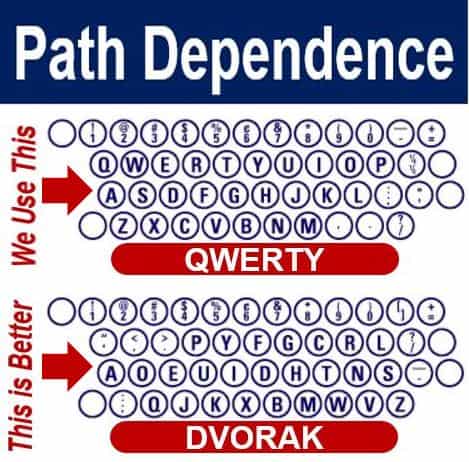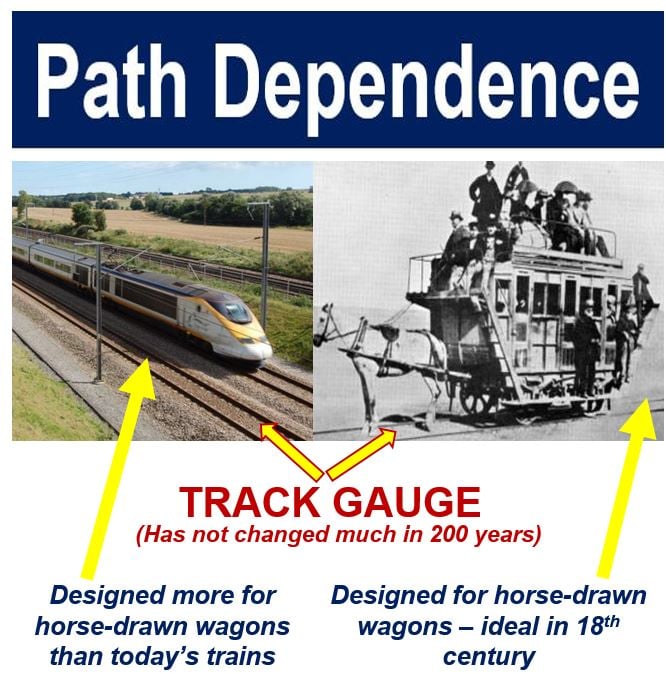By definition, path dependence explains how history really matters – where we have been in the past determines where we currently are and where we can go in future. Even tiny, seemingly trivial differences in the path we have taken may have enormous consequences for where we are and can go. Path dependence, in economics, refers to how apparently insignificant choices and events can have enormous consequences for the development of an economy or a market.
Path dependence is the notion that decisions people are faced with now depend on previous decisions or choices made and past knowledge trajectory, so they are limited by the current competence base.
In other words, our current decision-making situations are determined by history – what happened in the past has a huge influence on today’s strategic planning.
Path dependence is a concept from complexity theory that emphasizes how current and future options are shaped by past events. In other words, because the economy and business organizations function as nonlinear dynamic systems, even small differences in their starting conditions can be amplified over time, meaning that their historical trajectory largely determines where they can head in the future.

Originally, the weird order of QWERTY was due to the limitations of the first typewriters. Whenever two neighboring keys were pressed at a fast pace, a physical error occurred inside the machine – the pressed letter would ‘crash’. Inventor Christopher Sholes distributed the ‘most used keys’ as far away from each other as possible. We no longer have that problem with our word processors, but we continue using the inferior QWERTY keyboard. This is a popular example of path dependency. (Image: adapted from blogs.cornell.edu)
When we make decisions today, many of the options available to us now are in large part due to decisions and choices we made in the past.
Path dependence – are we creatures of habit?
Path dependence is the tendency of past (traditional) practice or preference to continue now and in the future, even if we have better alternatives today.
Even when past circumstances are no longer relevant, the decisions people and businesses face for any current circumstance is limited by what had been decided in the past.
For example, look at the QWERTY layout of keyboards that have remained unchanged virtually ever since the first commercial typewriter came out 140 years ago.
We still use that layout in all modern laptops and electronic communication devices, even though other layouts would allow for faster typing.

Four feet 8-1/2 inches (1.435 meters) is the standard gauge for railways across most of North America and Europe. It has been the most common gauge since the 1820s. Why do our current 200 km/h trains not have have wider gauges? Is it because the initial cost of changing hundreds of thousands of miles of track would be too high? Most economists say it is due to path dependence – what we did in the path determines what we have now.
The video cassette war
In the 1970s, two video formats existed – VHS and Betamax. For a number of years the two formats fought fiercely for market dominance.
For reasons experts even today disagree on, in the 1980s VHS started winning that war. VHS’ small lead grew over time for a number of reasons.
– The bandwagon Effect: video-cassette manufacturers in Europe and North America switched to the VHS format because they predicted that it was bound to win the standards battle – given that its lead was beginning to grow.
As more and more of them switched, the changeover snowballed.
– Network Externality: the term refers the value of a product to a user, which depends on how many people use it, or how extensive a network is.
If I have a smartphone, and just one other smartphone exists in the world, I can only communicate with that person – it is a network of two – its value to me is pretty low. However, if there are one billion other smartphones, my product is extremely valuable to me, because I can communicate with more people, and visit the myriad services online (which would not exist if there were only two of us).
Video rental stores noticed that more people were purchasing VHS players for their homes, and were also stocking up on VHS tapes, which in turn led to other people buying VHS players …. etc. …. until there was a total vendor lock-in to VHS.
After a while, it did not matter whether Betamax was better than VHS or vice-versa, a short history of the two had been created and VHS was the winner. That short history would determine what would happen in the future – VHS dominated the video-cassette market globally until the arrival of compact disks, memory sticks, the Internet and The Cloud.
Path dependency – the factory and houses
Path dependency explains why people continue doing things in a certain way based on the historical use or preferences. Even if something newer and better is available, because of previous commitments made, people reject the better alternative.
It is easier for us to continue along an already set path than to carve out a completely new one.
Imagine a town that was built around a factory. It would be better for the residents’ health, road networks, overall space in the town center, and levels of noise if the factory were located just outside the town.
However, when that factory was initially built, its workers needed somewhere to live nearby – they also wanted amenities to be close by.
Moving that factory – once it has been established – out of town would be too costly, even though it would be better for local residents.
Quirks of accident
Economists have always talked about how much history matters. Adam Smith’s ‘The Wealth of Nations’ has much to do with the buildup of capital of every sort: our investing, saving, inventing and studying. All of this is history.
Some economic and social historians have raised concerns recently that our current economic circumstances may depend in major ways on historical quirks of accident. Our current circumstances, they add, may depend on these accidents and quirks in particularly perverse ways.
Our current circumstances which we inherit, or the future that we build, may come about not as a result of preferences and legacies – the inevitable forces or important givens of economic history – but rather from minor things that might easily change if only we had realized how much we were affected by them.
A shelter which was built in a clearing for no significant reason led to the development of a village, which then became a town and then a major city.
A random experiment with one technology led to further experiments with that particular technology, which increased its advantages over others that were never tried.
In an article – Path Dependence – written by Sephen E. Margolis from the Department of Economics at North Carolina State University, and S. J. Liebowitz, from the Management School at the University of Texas at Dallas, the authors wrote:
“In each instance, we build on what we have, making the best of it. In this context, individuals may have limited incentives to examine whether what we have is what we ought to have and limited opportunity to effect a change.”
“Are we optimizing in some global sense, or are we just finding some minor, local and insignificant optimum? This is the concern raised by path dependence as it has been applied to economic allocations.”
The following quote comes from and article – ‘From systems and tools to networks and infrastructures – from design to cultivation. Towards a theory of ICT solutions and its design methodology implications’ – written by Ole Hanseth, published by the University of Oslo’s Department of Informatics:
“The US standard railroad gauge (distance between the rails) is 4 feet 8.5 inches. That’s an exceedingly odd number. Why was that gauge used? Because that’s the way they built them in England, and English expatriates built the US railroads.”
“Why did the English build them like that? Because the first rail lines were built by the same people who built the pre-railroad tramways, and that’s the gauge they used. Why did ‘they’ use that gauge then? Because the people who built the tramways used the same jigs and tools that they used for building wagons, which used that wheel spacing.”
“Okay! Why did the wagons have that particular odd wheel spacing? Well, if they tried to use any other spacing, the wagon wheels would break on some of the old, long distance roads in England, because that’s the spacing of the wheel ruts. So who built those old rutted roads? The first long distance roads in Europe (and England) were built by Imperial Rome for their legions. The roads have been used ever since.”
Uncertainty and path dependence
Why did the steam engine linger on long after the electric motor became available in the 1880s? Why is your keyboard designed the way it is, while superior and more efficient alternatives are readily available? Why is the standard gauge for railways the same as it was two centuries ago, when it was designed for horse-drawn wagons, not 200 km/h trains?
